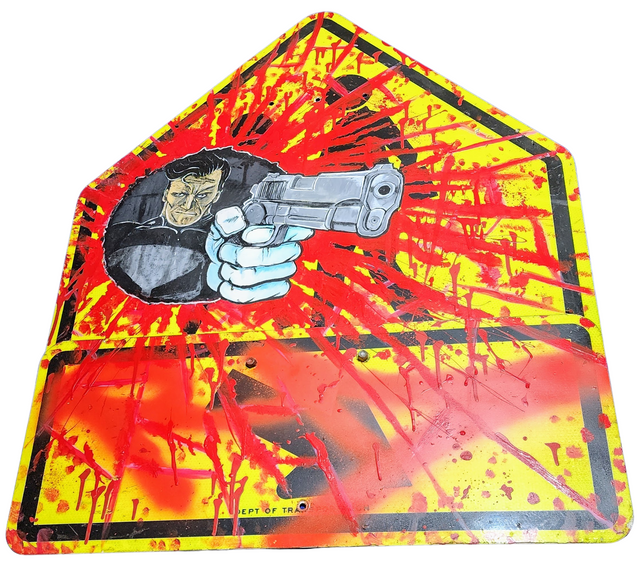
Street Signs
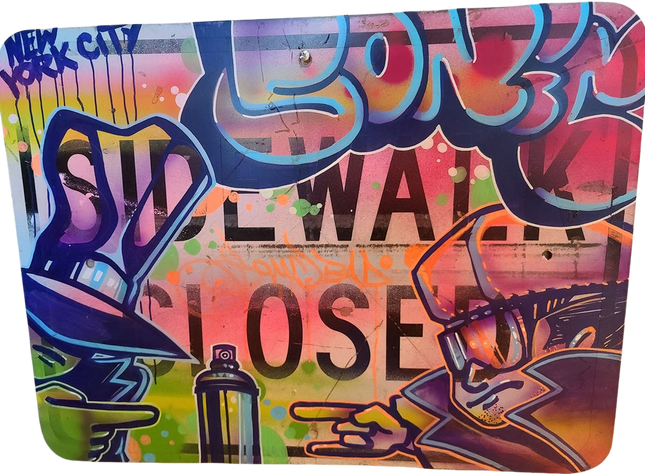
Sonic Bad Sidewalk Closed Original Mixed Media Street Sign Painting by Sonic Bad
Sidewalk Closed Original Mixed Media Graffiti Artist Modern Pop Art on Real Metal Street Sign by Sonic Bad. 2012 Signed Original Spray Paint & Metal Street Sign Artwork Size 24x18 Depicting 2 1970s-80s Stylized Beat Boys, NYC Graffiti Tags & Bubble Letters on Street Closed Sign Sonic Bad's Ode to the Streets: The 'Sidewalk Closed' Series The 'Sidewalk Closed' artwork by Sonic Bad, an original piece created in 2012, infuses the rebellious spirit of 1970s and 80s street culture into a medium that is emblematic of urban restriction: a real metal street sign. This mixed media work, signed by the artist, is a striking example of how street pop art and graffiti can repurpose public regulatory objects into canvases that challenge and reinterpret their original intent. Reclaiming Urban Symbols in Street Art Sonic Bad's choice of canvas—a metal street sign—turns an everyday symbol of control into a representation of creative liberation. The artwork, sized at 24x18 inches, is vibrant with color and life, presenting a stark contrast to the sign's mundane purpose of demarcating boundaries. By painting over it, Sonic Bad claims the object for art, much like graffiti artists claim walls for their tags and murals. The piece itself is a dynamic collage of NYC graffiti tags and bubble letters, styles deeply rooted in the history of street art. It showcases two stylized beat boys, figures that resonate with the hip-hop culture that was burgeoning on the streets of New York City during the 70s and 80s. These characters are not only representations of a specific era but also symbols of the energy and rhythm of street life. The Visual Language of Graffiti and Its Evolution Sonic Bad's work serves as a visual lexicon of graffiti's evolution, encapsulating the transition from tagging—often a raw, text-based expression of identity—to more complex and stylized works. The 'Sidewalk Closed' series is particularly evocative of this shift, highlighting the movement from simple letterforms to elaborate and colorful representations that are as much about the artistry of the line as they are about the message. The aerosol paint, a medium synonymous with graffiti, brings authenticity to the piece, its drips and opacity echoing the textures of street art seen in the wild. The metal sign, once reflective and directive, becomes muted and textured under layers of paint, a metaphor for the way street art can change the nature and conversation around public spaces and objects. Sonic Bad and the Living History of Street Art Sonic Bad's 'Sidewalk Closed' is more than a singular work; it is part of the living history of street pop art and graffiti artwork. It reflects a time when street culture began to permeate every aspect of urban life, from the music that played out of boomboxes to the art that adorned the walls and sidewalks of the city. This piece is a celebration of that era, a nod to the roots of street art, and a statement on its enduring influence. The artist, by merging nostalgia with contemporary expression, invites onlookers to explore the depth and breadth of street art. Through this work, Sonic Bad not only pays homage to the pioneers of the genre but also places himself within the continuum of artists who have utilized the street as their gallery. His legacy lies in his ability to transform the ordinary into the extraordinary, ensuring that the spirit of the streets remains vibrant and visible.
$2,000.00
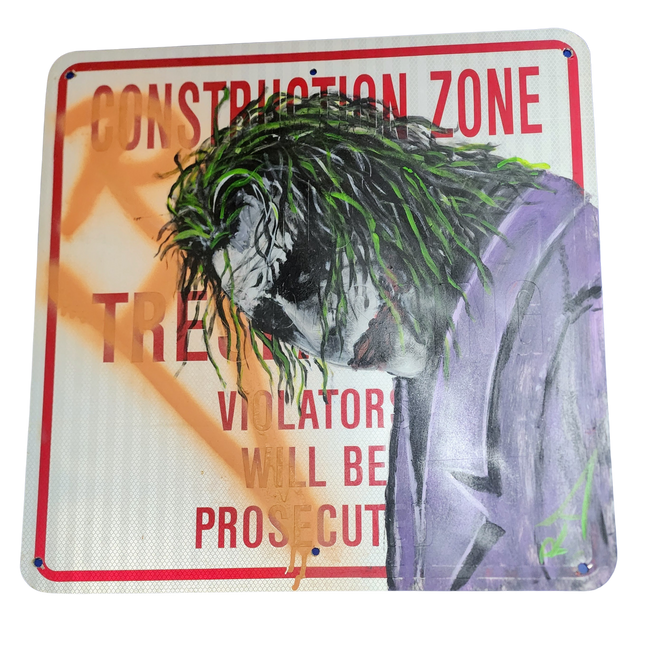
RD-357 Real Deal Ledger Joker Construction Street Sign Painting by RD-357 Real Deal
Heath Ledger Joker Construction Zone Original Street Sign Painting by RD-357 Real Deal One of a Kind Artwork on Real Metal NYC New York Construction Zone No Trespassing Street Sign by Graffiti Art Pop Artist. 2012 Signed Mixed Media Acrylic & Spray Paint on Reclaimed NYC New York Construction Zone No Trespassing Sign Painting Original Artwork Size 24x24 Batman Villian Played by Heath Ledger in the Movie as Joker Looking at the Viewer. RD Tag in Rust Red. RD-357's Heath Ledger Joker: A Fusion of Street Pop Art and Iconography The Heath Ledger Joker Construction Zone original street sign painting by RD-357, also known as Real Deal, encapsulates the essence of street pop art through its provocative use of public signage repurposed for artistic expression. Created in 2012, this mixed media acrylic and spray paint artwork transforms a New York City construction zone 'No Trespassing' sign into a canvas, depicting the iconic Batman villain played by Heath Ledger in a way that both challenges and captivates the viewer. Contextualizing RD-357's Artistic Approach RD-357, an artist whose real name remains elusive in the true spirit of street art anonymity, is known for his gritty interpretations of pop culture figures on unconventional canvases. This particular artwork measures 24x24 inches and is a testament to street art's versatility, pushing beyond traditional boundaries. RD-357 draws upon the anarchic spirit of the Joker, using a symbol of law and order – a construction sign – to present an image of chaos and rebellion. The irony is palpable; the sign, which once stood as a warning against unauthorized entry, now invites viewers to engage with the art in a personal, almost aggressive manner. Symbolism and Impact in RD-357's Joker Artwork This piece is not just a portrait; it is a statement. By choosing Heath Ledger's Joker, RD-357 taps into the collective consciousness of a society fascinated by the anti-hero archetype. Ledger's portrayal of the Joker was posthumously celebrated, and his death in 2008 left a cultural imprint that RD-357 leverages in this artwork. The juxtaposition of the Joker’s figure against the backdrop of a New York construction sign speaks volumes about the chaotic undercurrents within the perceived order of urban life. The use of mixed media, with acrylic and spray paint, highlights street art's raw, visceral nature, while also paying homage to the vibrancy of pop art. The viewer is confronted with the Joker's gaze, which, coupled with the bright warning colors of the construction sign, creates an unsettling yet magnetic presence. This interaction compels the audience to contemplate the layers of meaning behind the piece – from transforming public property into a medium for personal expression to the dialogue between art and spectator that challenges societal norms and the very definition of public space. In conclusion, RD-357's Heath Ledger Joker on a New York City construction sign is an outstanding example of how street pop art can merge cultural iconography with subversive messaging. Through this piece, the artist immortalizes a beloved film character and raises questions about authority, ownership, and the role of art in public discourse. The artwork remains a one-of-a-kind testament to the power of graffiti art to redefine spaces and provoke thought long after the paint has dried.
$3,000.00

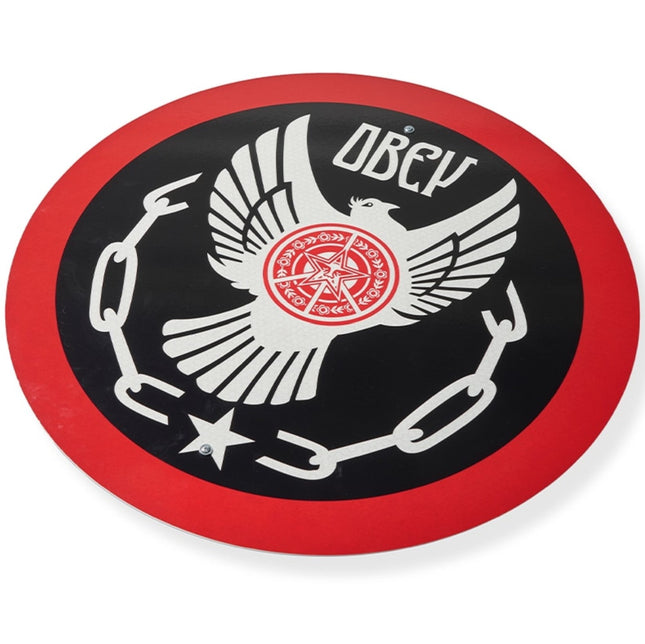
Shepard Fairey- OBEY Peace & Freedom Dove Metal Street Sign Print by Shepard Fairey- OBEY
Peace & Freedom Dove Metal Street Sign Limited Edition 2-Color Silkscreen Print on Street Sign Material Graffiti Modern Pop Art by Artist Shepard Fairey x Beyond The Streets. 2021 Metal Reflective Street Sign With Attached Signed COA Edition of 350 Size 24x24
$1,675.00
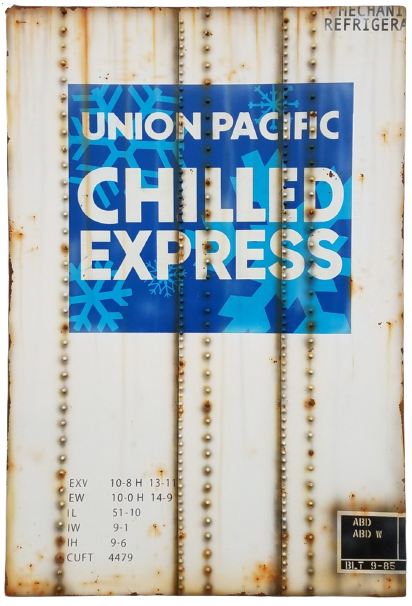
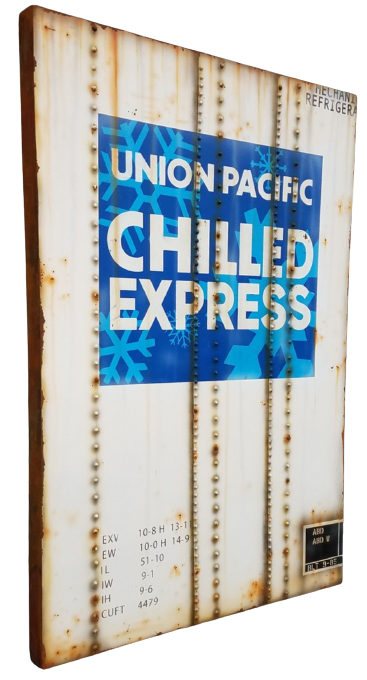
Lyric One Union Pacific Chilled Express Street Sign Original Acrylic Painting by Lyric One
Union Pacific Chilled Express Original One of a Kind Acrylic Paint Painting Artwork on Studded Distressed Cradled Wood by Popular Street Graffiti Artist Lyric One. 2019 Signed Hand-Painted Ready To Hang Original Acrylic Paint Wood Panel With Realistic Raised Rivets Size: 24 x 36 Inches Release: August 15, 2019 Capturing the Essence of Transient Motion in Street Art The 'Union Pacific Chilled Express' is a striking original acrylic painting by the famous street graffiti artist Lyric One. This 2019 hand-painted piece on a studded distressed cradled wood panel, with realistic raised rivets, measuring 24 x 36 inches, embodies the fusion of street pop art and graffiti artwork. It resonates with the movement and commercial vibrancy that are the lifeblood of the railroads, an homage to the transient nature of both freight and art. Industrial Narratives in Lyric One's Work Lyric One's artistic endeavor into the world of transportation and industry is encapsulated in this significant work. The subject matter – a Union Pacific refrigerator car used for transporting perishable goods across vast distances – is not a common muse for artists. However, Lyric One elevates this everyday industrial object to a piece of art, meticulously capturing the textures and surfaces that tell a story of travel, trade, and the passage of time. The artwork, signed and ready to hang, was released on August 15, 2019. It reflects the artist's deft ability to translate street pop art's ethos onto various canvases. The choice of distressed wood and the attention to detail, such as the raised rivets, are reminiscent of the textures found in urban environments. These rivets add a tactile element to the piece and echo the industrial nature of rail transport – each one could represent the countless connections and junctions found along the rail networks. Symbolism and Aesthetics in Graffiti Artwork In 'Union Pacific Chilled Express,' the contrast between the practical function of the chilled express service and the vibrant expression of graffiti art is striking. The bold, ice-blue lettering against the stark white background captures the viewer's attention, drawing them into a world where the industrial and the artistic collide. Snowflake motifs not only signify the refrigeration aspect but also add an element of fragility, a subtle nod to the impermanence often a theme in street art and the world of commerce. Lyric One's work is a testament to the dynamism of street pop art. With each brush stroke on the cradled wood, the artist brings to life the hum of the railway lines, the chill of the cargo holds, and the omnipresence of industry in our daily lives. The artwork is not just a static piece to be admired; it is an active participant in the dialogue about the role of industry in society and the omnipotent influence of commerce in our visual culture. This piece by Lyric One reminds us that street pop art and graffiti artwork are not confined to walls and alleyways but are dynamic forms that can transform any surface into a narrative. The 'Union Pacific Chilled Express celebrates this versatility and the ability of street artists to capture the essence of motion, industry, and life's transient nature in their work.
$2,500.00







